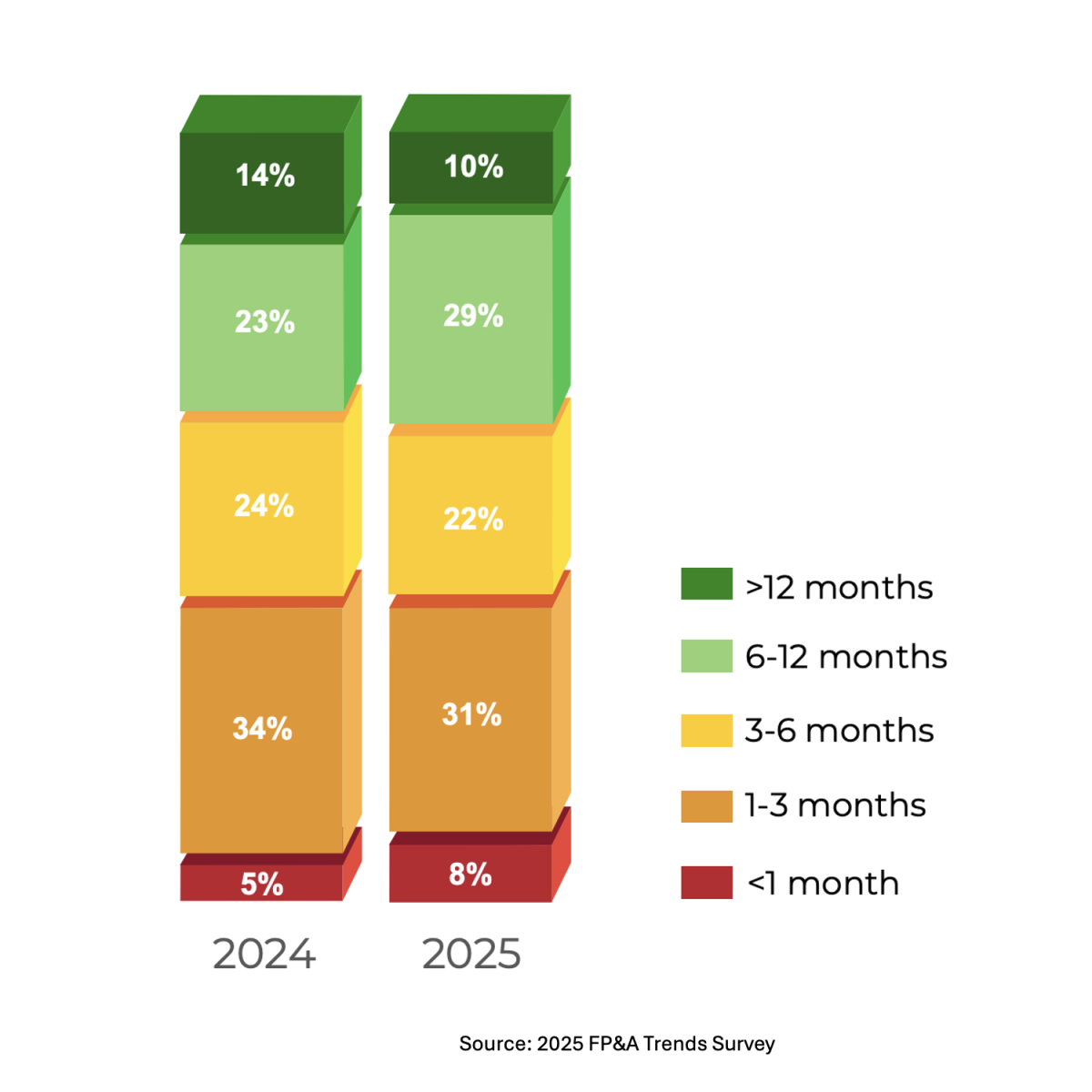In this article, discover how FP&A teams can recognise, monitor, and address earnings management practices that...
There was a time when business plans were truly strategic maps that guided companies toward long-term growth, innovation, and leadership. Nowadays, it feels like planning has become something else: a way to lock in short-term numbers and figure out bonus payouts.

What should be a strategic process turns into a yearly exercise in setting targets, revenue, margin, cost, KPIs, with one eye on the number and the other on the bonus. It is no longer about where we want to go, but about how to have a comfortable year.
The cost? A more cautious, less ambitious culture. And this isn’t just a feeling — the 2025 FP&A Trends Survey shows that 61% of companies say they can only plan with confidence up to six months ahead, while just 10% can see beyond a year (see Figure 1). In other words, the short-term mindset has become the norm.
When compensation is tied to hitting targets, every layer of the organisation starts playing it safe: adding costs, underestimating revenue, lowering expectations. It is clear that people want to protect their bonuses, but over time, this affects the company’s real potential. And when these conservative assumptions moved to numbers, they compounded. By the time the final plan is finally approved, it is often more of a risk-management tool than a roadmap for growth. I have seen talented teams shift from possibility to predictability, optimising for certainty instead of thinking bigger.
A Real-Life Example
I worked with a global consumer goods company that was facing this exact issue. Year after year, teams would lowball their revenue forecasts to make sure they hit their bonus targets. Leadership started noticing that actual results consistently beat the plan, but overall growth was flat. The company wasn’t missing the plan… but it also wasn’t pushing itself.
Finally, leadership made a move. They split bonus structures from the conservative plan, created separate operational forecasts and stretch targets, and started rewarding teams for both solid execution and bold initiatives. It took time, but the culture started to shift. People began thinking creatively again, and new opportunities started to emerge.
What We Can Do in FP&A
As a planning team, we’re able to change this dynamic. Here’s how we can help:
1. Encourage ambition: Challenge conservative thinking. We can push for bold but grounded targets that stretch our teams instead of letting them time for a good nap.
2. Separate forecasting from incentives: It is hard to get honest projections when bonuses are on the line. Decoupling them makes the numbers more meaningful and useful.
3. Use dual targets: Have a baseline forecast for operating decisions and a stretch goal to rally behind. They serve different purposes, and both matter.
4. Build flexibility into the plan: Plans should not be set in stone. The world changes fast. We need frameworks that allow us to adapt without being penalised for it.
In conclusion, FP&A is about more than numbers. Our job is a mix of pushing back when it is needed and supporting when it matters. Since we sit right between data, strategy, and performance, we can help shift the conversation from “just the figures” to “what do these figures really mean.”
One of the best tools we have is scenario analysis. It helps leaders see the upside of bold moves and also the cost of playing it too safe. We can also make planning more transparent by creating spaces where assumptions are openly discussed, not tucked away.
Working closely with business teams, we can show how smart growth bets usually pay off over time, even if they look risky in the short term. Another part of the role is education, helping people see the difference between a realistic forecast and an aspirational target, and why both are actually needed.
And here is the reality: only 9% of FP&A teams today are seen as true strategic advisors to the business [1]. That is a huge opportunity. If we step into that role, we can move planning away from “bonus management” and back toward ambition and leadership.
And finally, agility. Rolling forecasts, quick updates, adapting fast — this is what makes planning useful in the real world. When FP&A takes on this kind of role, planning stops feeling like a checkbox exercise and becomes a driver of strategy and ambition.
What this Means for us in FP&A
• Don’t play it too safe: Targets should stretch us, not just protect bonuses.
• Keep forecasts honest: Decouple them from incentives so the numbers actually mean something.
• Have two goals, not one: A solid baseline to run the business, and a bold stretch target to aim higher.
• Stay flexible and bold: Use scenarios, rolling forecasts, and open conversations to keep plans alive and ambitious.
Planning with Purpose Again
If we want planning to be a driver of leadership, not just compliance, we must rethink how we define success. It is not just about hitting the easiest number. It's about setting meaningful, ambitious goals and creating space to pursue them. That is when planning becomes real again — a tool for direction, not just protection.
Source:
Subscribe to
FP&A Trends Digest

We will regularly update you on the latest trends and developments in FP&A. Take the opportunity to have articles written by finance thought leaders delivered directly to your inbox; watch compelling webinars; connect with like-minded professionals; and become a part of our global community.







